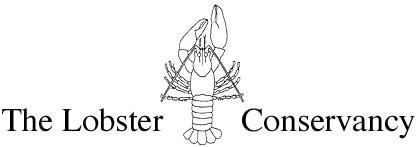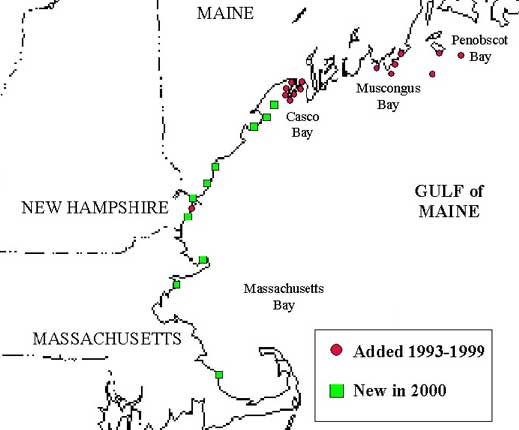
P.O. Box 235, Friendship, ME 04547 (207) 832-8224 www.lobsters.org

P.O. Box 235, Friendship, ME 04547 (207) 832-8224 www.lobsters.org
October 21, 2000
Dear Volunteers and Friends of The Lobster Conservancy,
For those of you who may be unfamiliar with The Lobster Conservancy, our purpose is to ensure healthy populations of the American lobster (Homarus americanus) and preserve the traditional trap fishery that depends on this resource. We are primarily a scientific research organization. This newsletter keeps our friends and volunteer research team informed of our activities.
Research News
Volunteer Program
We are pleased to announce that we have received a second round of support from the Greater Piscataqua Community Foundation, thanks to the Barbara K. and Cyrus B. Sweet III Fund and the Otto Fund. This support will help us keep the volunteer program up and running in New Hampshire and southern Maine in 2001 and establish a new monitoring site near Hampton or Seabrook, NH.
Volunteers were out monitoring juvenile lobsters again in late September, the second to last month of Baby Lobster Watch 2000. Unfortunately, the predicted spring tides were not as low as usual and storm surges in some areas kept water levels higher than predicted. Shorter days also led volunteers to experience their first pre-dawn and post-dusk sampling of the season, with darkness adding a new challenge. Nonetheless, volunteers were able to find juvenile lobsters at most sites from Maine through Massachusetts.

TLC has more than 60 volunteers monitoring 25 lobster nursery sites around the Gulf of Maine.
In Penobscot Bay, it was a family affair on Matinicus Island where Emily, Eric, Eva, and Paul Murray scoured Condon Cove to find 1 lobster that measured 45 mm in carapace length (CL). On Isle au Haut, Trent and David Quinby have taken over for Kipp Quinby who is off to school in Norway this year. The Quinby team found 8 lobsters (15-56 mm CL) in Moore's Harbor. On Vinalhaven, John and Ginger Van Ness sampled in rocky habitat one day and found 4 lobsters (47 –58 mm CL) in 10 quadrats. They had to go back a second day to sample in eel grass, where they found another 4 lobsters (46-70 mm CL) in 10 quadrats. At Waterman Beach, Alfred Petterson, Annette Naegel, Leslie Fuller, and Ben Neal found 5 lobsters (31–44 mm CL) along their transect and another 5 (51-86 mm CL) during random sampling. At Drift Inn Beach, Jane Roundy and Julie Wortman have been rebuilding shelters that had been previously uprooted by beachcombers. They found 8 lobsters (29-51 mm CL) in September, which was up from the last 2 months.

Volunteers Julie Wortman (left) and Jane Roundy have been monitoring juvenile lobsters in Port Clyde, Maine for 3 years. Photo by Sara Ellis
In Eastern Casco Bay Corie Bibber Logan got skunked at Mackerel Cove, but made up for that disappointment at her second site, Little Harbor, where she found 11 lobsters (4-52 mm CL), which included many that had recently settled out of the water column (< 11 mm CL). Frank Haims and Sara Ellis sampled 8 lobsters (13-52 mm CL) in 12 quadrats at Gun Point, under a tiny sliver of a moon. Amy Watson had lots of help from Jessica and Brina Watson, Ashley Moody, and Jamie Crossman at Cundy's Harbor, where the team found 5 lobsters (23-40 mm CL). Ned and Kathy Osolin picked a low tide with the greatest amount of daylight to boat out to their site on Jaquish Island. They found 7 lobsters ranging from 26 to 50 mm CL. (For more on Eastern Casco Bay, see Lowell's Cove, below.)
In Western Casco Bay, Mac Passano, Elizabeth Howe, and Elizabeth Passano were forced to sample at a higher tidal height than usual at Bennett's Cove, Chebeague Island. Although they sampled a full 20 quadrats, they did not find any lobsters this month. Similarly at Broad Cove on Cape Elizabeth, Mike Doan, Mary Cerullo of Friends of Casco Bay and Helen Muther found only 1 lobster (60 mm CL), which had molted recently. Elsewhere on Cape Elizabeth, Professor Jack Ney and Odessa Bedard of Southern Maine Technical College found 7 lobsters (19-52 mm CL) among the rocks at Zeb Cove.
In Southern Maine, Enid White and Patrice Farrey were foiled by the tidal height since their regular transect was not exposed at all. They tried some random sampling but the lobsters in Lobster Cove, York were all out of reach.
In New Hampshire, Timothea Jousse and Julie Ligon found 6 lobsters (28-40 mm CL) at Odiorne Point State Park. In New Castle, John and Carolyn Payzant and "Jumbo" Jervis braved the early, chilly morning to find 12 lobsters (30-53 mm CL).
In Massachusetts, Gloucester monitors Pat Earle, Astrid af Klinteberg, and Cindy Dunn found 5 lobsters (24-32 mm CL), including a super-fast one that managed to clamp right on to Astrid! In Marblehead, Sean Sullivan and Jack Arnold shifted slightly from their regular transect due to the higher tide, but still managed to find 18 lobsters in 20 quadrats (14-48 mm CL), indicating once again what a rich nursery ground this is.
Long-term Tagging of Juvenile Lobsters
Diane sampled at Lowell's Cove on two low tides with help from Polly Wilson, Ellen McCarty, and Sara. Although they found 39 lobsters during one of those low tides, they weren't able to sample the usual transects. It was not possible to sample all the regular quadrats due to tidal height and storm surge, but they looked for, and found, tagged lobsters in different parts of the cove. Diane went back on her own and finally managed to reach 9 of her quadrats. She found 18 lobsters, including young-of-the-year and recently-molted individuals.
On Friendship Long Island, Diane monitored Deep Cove on the next two consecutive low tides, covering one 10-meter transect on her own and the other with help from Sara. They were still was unable to sample all of the usual quadrats. It was exciting to find 4 lobsters (13-62 mm CL) together under one rock.
Lobster Life Study Center
Several of the pound lobsters have molted recently, and have retained the experimental identification tags that we injected into their walking legs. This is exciting news since these tags, which can be scanned electronically, have never before been used on lobsters. Retention of the tags throughout the molt will allow us to keep track of individuals over time in various experiments.
On October 16th, visitors from Friends of Casco Bay (FOCB), Bowdoin College, and TLC friend and volunteer Helen Muther toured the Lobster Life Study Center. We've been partnering with FOCB since early this year to expand the Baby Lobster Watch in Casco Bay, and are working on a new service learning project with Bowdoin (see below). Professor Ed Laine of Bowdoin conducted CTD casts in the pound to measure physical parameters including conductivity (for salinity), temperature, and depth. The group of 13 proved that they had "The Right Stuff" as they cheerfully braved rain, hail, and snow (yes snow!) to learn about the workings of a lobster pound and our research at the Lobster Life Study Center. Maybe filling our belly's at Moody's Diner beforehand helped keep spirits high.
Outreach and Education
As reported last month, we are setting up a new service-learning project with Professor Ed Laine of Bowdoin College. Students will try to shed light on geological factors controlling the distribution of juvenile lobsters within Lowell's Cove. This new project follows on the success of last year's service-learning project in which Bowdoin student Amy Trumbull created prototype GIS maps of transect locations at 5 of TLC's lobster monitoring sites in Harpswell, with guidance from Harpswell volunteers Corie Bibber Logan, Amy Watson, and Ned and Kathy Osolin.
On October 9th, Diane gave a presentation at Burcham Hills in East Lansing, Michigan, entitled "The Lobster Lady." Her presentation featured special guest George Geier, video of the lobster pound by John Cowan, and photos by Carol Lundquist.
Press Coverage
A new article on Diane's work at the lobster pound was featured in the November 2000 issue of National Fisherman, entitled "Thinking Big: With the Help of Fishermen (and large crustaceans), a Maine Scientist Seeks a Link between Inshore and Offshore Populations." The article included quotes by Friendship lobsterman, Henry Thompson, Sr., and mentioned TLC volunteer Enid White of York, Maine.
Back in August, Marcella Bombardieri wrote an article on Diane and TLC in the Boston Globe, called "Lobster Shift." We have been amazed to find how far and wide this article has spread. It was reprinted in the Providence Journal on August 15 as "Jane Goodall of Lobsters: Her Passion and Her Dinner," and in the Detroit Free Press, September 7. We hear it made it into the Miami Herald as well. Please let us know if you come across it anywhere else. We plan to post these articles on the press page of our web site (www.lobsters.org/press/press.php).
Well, that's all for now. Stayed tuned for next month's report.
Yours in TLC and Friendship,
Sara Ellis, Executive Director and Diane Cowan, Senior Scientist